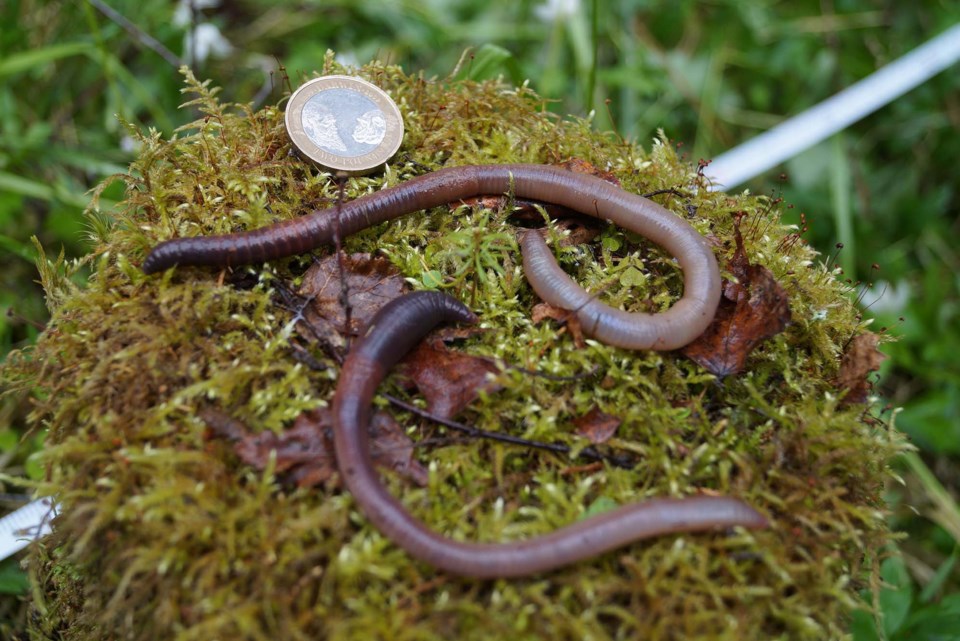Earthworms may be eating Alberta’s forest bugs out of house and home, and a St. Albert scientist says this could have major implications for biodiversity and climate change.
Leipzig University ecologist Malte Jochum co-authored a study in Biology Letters March 30 on how invasive earthworms altered surface-dwelling insect communities in a forest near Barrier Lake in Alberta’s Kananaskis Valley.
Earthworms are a relatively new addition to Alberta’s forests as they were wiped out during the last ice age, said Erin Cameron, a St. Albert environmental science professor at St. Mary’s University familiar with Jochum’s study. (Researchers suspect these worms were reintroduced to North America by settlers.) Earthworms were first spotted in Alberta at the Barrier Lake forest in 1980 — now, they have been found in about 10 per cent of Alberta forests and along 60 per cent of its roadsides.
In an email, Jochum said researchers have long known that these invading earthworms could have severe effects on Alberta’s forests. As most research had focused on their subsurface impacts, he decided to study their above-ground effects.
Wriggly homewreckers
Jochum’s team collected plants, bugs, and worms from 60 one-by-two-metre plots in a forest near Barrier Lake in summer 2019. This involved hand sorting worms from clumps of dirt, pouring mustard-laced water on the ground to irritate worms to the surface, and bug-sucking vacuums.
The team found that worm-dense plots had 61 per cent fewer arthropods, 27 per cent less biomass, and 18 per cent less species richness than worm-sparse ones. Worm-heavy areas had fewer herbivores, detritivores, and omnivores, but more parasitoids and predators (mostly tiny spiders).
Jochum said this shows how earthworms had “devastating” impacts on the forest and its food webs.
“Across community properties and across functional groups of above-ground arthropods, there were almost unequivocally negative effects,” he said, adding that he was surprised by the clarity of this result.
While Jochum’s team was not able to determine why the worms had these effects, Cameron said researchers suspect the worms may be eating the same layer of detritus in which many forest bugs live.
“It’s like having your house eaten.”
Previous studies suggest earthworm invasions can reduce plant diversity and promote invasive plants, which could affect herbivores who depend on native plants, Jochum said. (Surprisingly, the team did not see significant worm-related plant effects in this study.) The earthworms in this study may have somehow changed plant communities to favour tiny spiders, explaining why his team found more of them in worm-heavy regions.
Is this a problem?
Jochum said the earthworm invasion of North America is a problem if you like or depend on our forests being the same as they were for the last few millennia, given that they wipe out other species and destabilize ecosystems.
Cameron said it is not yet clear if these earthworms are a major ecological threat — this study was done in a deciduous forest, and worms might have lesser effects in coniferous ones or in sandy or acidic soils. Still, earthworms could have a significant effect on carbon storage in soil, which would affect global heating. Lab studies also suggest earthworms can wipe out more than half of the invertebrates in a region, once introduced.
There’s no way to remove earthworms once they’re established, Jochum and Cameron said. Instead, Albertans should slow their spread by not leaving unused bait worms at lakes and streams and cleaning boots before hiking in remote areas. Earthworms typically advance just five to 10 metres a year on their own, but can move much faster with human help.
Jochum said this research suggests scientists should account for the effects of earthworms on above-ground insects when managing biodiversity in North American forests.
The study can be found at bit.ly/3uUBlSa.




